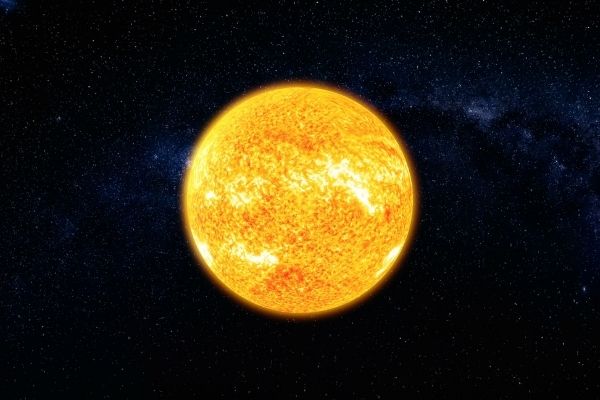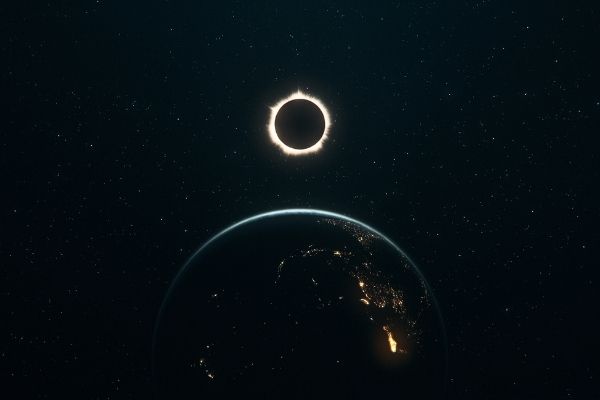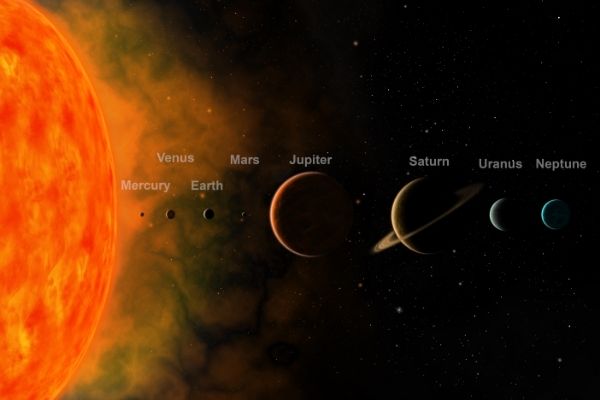The Sun is the star at the center of our Solar System and is the most important source of energy for life on Earth. It is a gigantic, glowing ball of gas that has been shining for more than 4.6 billion years. The Sun is a fascinating object that is full of interesting and amazing facts that can captivate the imagination of children. From its size to its temperature, from its role in the formation of our Solar System to its impact on Earth’s climate, there is much to discover about this incredible celestial body. In this article, we will explore some fun and fascinating Sun Facts For Kids that kids will love to learn.
Sun Facts For Kids
What Is Our Sun
Our Sun is a star located at the center of our Solar System. It is a gigantic, glowing ball of gas, primarily made up of hydrogen and helium, that generates energy through a process called nuclear fusion. The Sun’s immense gravitational pull keeps the planets of our Solar System in orbit around it, and its heat and light make life on Earth possible. The Sun is an average-sized star, but it is still incredibly massive, with a diameter of about 1.4 million kilometers (870,000 miles) – over 100 times larger than Earth’s diameter. The Sun’s temperature at its core reaches about 15 million degrees Celsius (27 million degrees Fahrenheit), making it an extremely hot and powerful celestial body.
What Is Sunlight
Sunlight is the radiant energy emitted by the Sun, which includes visible light as well as ultraviolet and infrared radiation. Sunlight is essential for life on Earth as it provides the energy that plants use for photosynthesis, which in turn produces oxygen and food for animals and humans. Sunlight also regulates our body’s internal clock and is crucial for the production of vitamin D in our skin. Sunlight appears white, but it is actually made up of different colors that can be seen when light passes through a prism. The spectrum of sunlight ranges from violet (with the shortest wavelength) to red (with the longest wavelength). When sunlight passes through the Earth’s atmosphere, it can be scattered, which causes the blue sky and colorful sunsets.
Composition Of Sunlight
Sunlight is composed of different types of electromagnetic radiation, which include visible light, ultraviolet radiation, and infrared radiation. Visible light makes up a small portion of the spectrum of sunlight and includes the colors of the rainbow, ranging from violet (with the shortest wavelength) to red (with the longest wavelength). Ultraviolet radiation has a shorter wavelength than visible light and is not visible to the human eye. This type of radiation is responsible for causing sunburns and skin damage and is also essential for the production of vitamin D in our skin. Infrared radiation has a longer wavelength than visible light and is felt as heat. It is important for regulating the Earth’s temperature. Overall, sunlight is a complex mixture of different types of radiation that are crucial for life on Earth.
What Is Our Sun Made Of – Sun Composition
Our Sun is made primarily of hydrogen and helium, which together make up over 98% of its mass. The remaining 2% is made up of other elements, including oxygen, carbon, neon, and iron, among others. These elements are created through a process called nuclear fusion, which occurs in the Sun’s core where temperatures and pressures are extremely high. During fusion, hydrogen atoms combine to form helium, releasing an enormous amount of energy in the process. This energy is what powers the Sun and allows it to emit light and heat. The composition of the Sun is similar to that of other stars in our galaxy, and understanding the Sun’s composition is essential for understanding the evolution and behavior of stars in general.
Parts Of The Sun
The Sun is a complex and dynamic celestial object with several distinct layers or parts. The layers of the Sun can be divided into three main regions: the core, the radiative zone, and the convective zone.
What Is Inside The Sun
- Core: The core is the central region of the Sun where nuclear fusion occurs. This is where hydrogen atoms fuse together to form helium, releasing a tremendous amount of energy in the process. The core is the hottest part of the Sun, with temperatures reaching up to 15 million degrees Celsius.
- Radiative Zone: Surrounding the core is the radiative zone, which is a thick layer of dense gas where energy is transported through radiation. Energy produced in the core travels through the radiative zone in the form of photons, which can take millions of years to reach the Sun’s surface.
- Convective Zone: The outermost layer of the Sun is the convective zone, where energy is transported through convection. This layer is characterized by hot plasma rising to the surface, cooling and sinking back down, creating a continuous cycle of circulation. The convective zone is the most visible part of the Sun and is where sunspots and other surface features are observed.
In addition to these three main regions, the Sun also has a magnetic field that plays an important role in its behavior and is responsible for phenomena like solar flares and coronal mass ejections.
Photosphere
The photosphere is the visible surface of the sun. It is a boundary between the interior of the sun and the solar atmosphere.
The solar atmosphere
The solar atmosphere is a gaseous halo around the sun. It lies outside the visible surface of the sun. It is composed of:
-
- Chromosphere
- Solar transition region
- Corona
- Heliosphere
All these regions can be seen only during the solar eclipse when the major part of the sun is hidden.
Life Cycle Of Our Sun
 The life cycle of our Sun can be divided into several distinct stages, each characterized by different processes and changes in the Sun’s structure and behavior. The life cycle of our Sun can be summarized as follows:
The life cycle of our Sun can be divided into several distinct stages, each characterized by different processes and changes in the Sun’s structure and behavior. The life cycle of our Sun can be summarized as follows:
- Formation: Our Sun formed around 4.6 billion years ago from a cloud of gas and dust that collapsed under its own gravity.
- Main Sequence: For most of its life, the Sun will be in the main sequence stage, where it fuses hydrogen in its core to produce helium. During this stage, the Sun will maintain a stable energy output and will gradually increase in temperature and brightness.
- Red Giant: As the Sun runs out of hydrogen fuel in its core, it will start to fuse helium, causing it to expand and cool. This will cause the Sun to enter the red giant phase, where it will expand to several times its current size and its outer layers will become cooler.
- Planetary Nebula: In the next stage, the outer layers of the Sun will be expelled into space, creating a planetary nebula. The core of the Sun will remain behind, now a dense, hot white dwarf star.
- White Dwarf: Over time, the white dwarf will gradually cool and dim, eventually becoming a cold, dark object known as a black dwarf.
The entire life cycle of the Sun is estimated to last around 10 billion years, with the Sun currently in the middle of its main sequence phase. The exact length of each stage of the Sun’s life cycle depends on its mass, with more massive stars evolving more quickly than less massive ones.

When Was Sun Created
The Sun was created around 4.6 billion years ago, during a period of time known as the solar nebula stage. At this time, a large cloud of gas and dust in space began to collapse under its own gravity, eventually forming a spinning disk of material. The central region of this disk became increasingly dense, eventually forming the Sun. The remaining material in the disk would go on to form the planets, moons, asteroids, and other bodies that make up the Solar System. The exact date of the Sun’s creation is difficult to determine, but scientists estimate it occurred around 4.6 billion years ago based on the age of the oldest known rocks on Earth and the Moon.
How Was Sun Created – Where Did The Sun Come From
he Sun was created from a large cloud of gas and dust known as a molecular cloud. This cloud was composed mostly of hydrogen and helium, the two lightest elements in the universe. The cloud began to collapse under its own gravity, eventually forming a spinning disk of material with a dense core at the center. Over time, the core became denser and hotter, eventually becoming hot enough for nuclear fusion to occur.
Nuclear fusion is the process by which lighter elements are fused together to form heavier elements, releasing a tremendous amount of energy in the process. In the case of the Sun, hydrogen atoms are fused together to form helium, releasing energy in the form of light and heat. This process is what powers the Sun and allows it to emit energy into space.
The remaining material in the spinning disk eventually coalesced to form the planets, moons, asteroids, and other bodies that make up the Solar System. This process of planet formation is known as accretion and is thought to have occurred over millions of years. Overall, the Sun was created from the same material that makes up the rest of the Solar System, and its formation was the result of the complex interplay between gravity, temperature, and nuclear fusion.
What Is The Age Of the Sun
The current estimate for the age of the Sun is around 4.6 billion years. This estimate is based on a variety of evidence, including the age of the oldest rocks on Earth and the Moon, the ages of meteorites, and the age of the Solar System itself. Scientists use a variety of dating techniques to determine the ages of these objects, including radiometric dating, which measures the decay of radioactive isotopes in rocks and other materials.
The age of the Sun is an important factor in understanding its life cycle and its behavior over time. For example, scientists use the age of the Sun to estimate how much longer it will remain in its main sequence phase, where it fuses hydrogen to form helium. This information is important for understanding the long-term evolution of the Solar System and the potential for life to exist on other planets
What Is The Temperature Of The Sun
At the core of the Sun, where nuclear fusion occurs, the temperature is estimated to be around 15 million degrees Celsius (27 million degrees Fahrenheit). This is the temperature required to sustain the fusion reactions that power the Sun.
The temperature of the Sun decreases as you move outward from the core, and the outer layers of the Sun are much cooler. The surface of the Sun, known as the photosphere, has a temperature of around 5,500 degrees Celsius (9,932 degrees Fahrenheit). This is the temperature that is typically used when discussing the temperature of the Sun.
However, the temperature of the Sun’s atmosphere, known as the corona, is much hotter than the photosphere. The corona can reach temperatures of several million degrees Celsius, which is much hotter than the surface of the Sun. The reason for this temperature difference is not yet fully understood, and it is the subject of ongoing research by scientists.
What Is A Solar Mass
A solar mass is a unit of measurement used by astronomers to describe the mass of stars, including the Sun. One solar mass is equal to the mass of the Sun, which is approximately 1.99 x 10^30 kilograms, or 333,000 times the mass of the Earth.
Astronomers use solar masses to compare the masses of other stars to the Sun. For example, a star that is twice as massive as the Sun would be described as having two solar masses. Similarly, a star that is half as massive as the Sun would be described as having 0.5 solar masses.
The concept of a solar mass is important for understanding the life cycle and behavior of stars. The mass of a star determines how it will evolve over time and ultimately how it will end its life, either as a white dwarf, neutron star, or black hole.
What Is The Luminosity Of The Sun
The luminosity of the Sun is a measure of the total amount of energy that it emits per unit of time. It is typically expressed in units of watts or in terms of the Sun’s luminosity relative to that of the Earth (solar luminosities).
The luminosity of the Sun is estimated to be around 3.828 x 10^26 watts, which is equivalent to around 3.828 x 10^33 ergs per second. This means that the Sun emits an enormous amount of energy each second, most of which is in the form of visible light and other forms of electromagnetic radiation.
The luminosity of the Sun is an important factor in understanding its behavior and its role in the Solar System. It is the source of energy that powers the Earth’s climate, drives weather patterns, and supports all life on Earth. The luminosity of the Sun also determines its position on the Hertzsprung-Russell diagram, which is a plot of stars’ luminosity versus their surface temperature, and provides insight into the Sun’s evolutionary path.
What Does The Sun Look Like
o the naked eye, the Sun appears as a bright, glowing disc in the sky. It is the largest object in the Solar System and appears much larger and brighter than any other object in the sky.
When viewed through a telescope or other magnifying device, the Sun reveals a complex structure of dark spots, bright regions, and other features. These features are caused by variations in the Sun’s magnetic field and can change over time.
The outermost layer of the Sun, known as the corona, is visible during a total solar eclipse as a faint, wispy halo around the Sun. The corona is much hotter than the surface of the Sun and is made up of ionized gas particles that are constantly being blown away from the Sun by the solar wind.
It is important to note that looking directly at the Sun, even for a brief period of time, can cause permanent eye damage or blindness. It is never safe to look directly at the Sun without proper protection, such as special solar filters or eclipse glasses.
What Color Is The Sun – What Is The Real Color Of The Sun
Contrary to popular belief, the Sun is not actually yellow or orange in color, but appears white. This is because the light emitted by the Sun is made up of a broad spectrum of colors, including all the colors of the rainbow.
When the Sun’s light passes through Earth’s atmosphere, it is scattered in all directions, and the shorter blue and violet wavelengths are scattered more than the longer red, orange, and yellow wavelengths. This makes the sky appear blue and gives the Sun a slightly yellow or orange tint near sunrise or sunset when the sunlight has to pass through more atmosphere to reach our eyes.
However, when viewed from space, the Sun appears white because there is no atmosphere to scatter its light. In fact, many images of the Sun taken by space telescopes or spacecraft show it as a pure, bright white disk.
What Type Of Star Is The Sun
The Sun is a G-type main-sequence star, also known as a yellow dwarf. It is classified as a relatively small, cool, and stable star that has been shining for about 4.6 billion years.
G-type stars are relatively common in the Milky Way Galaxy, accounting for about 7% of all stars. They have surface temperatures ranging from about 5,000 to 6,000 degrees Celsius (9,000 to 11,000 degrees Fahrenheit) and emit most of their light in the yellow-green part of the spectrum.
The Sun is located in the middle of the main sequence of stars, which represents a stable phase in their lives when they are converting hydrogen into helium in their cores through nuclear fusion. As a main-sequence star, the Sun is expected to remain stable and shine steadily for several billion more years before eventually evolving into a red giant star.
What Will Happen When The Sun Dies
The Sun has about 5 billion years left before it exhausts the hydrogen fuel in its core and begins to evolve into a red giant star. During this process, it will expand and become much brighter, eventually engulfing Mercury, Venus, and possibly even Earth.
After a few hundred million years as a red giant, the Sun will shed its outer layers and evolve into a white dwarf star. At this point, it will have lost much of its mass and will no longer be able to sustain nuclear fusion reactions in its core.
The white dwarf will gradually cool over billions of years, eventually becoming a cold, dark object known as a black dwarf. However, this process will take trillions of years, so it is unlikely that any human beings or life forms as we know them will be around to witness it.
What Does The Sun Give Us
The Sun is essential for life on Earth and provides a wide range of benefits to us, including:
- Light: The Sun is the primary source of light on Earth, allowing us to see and go about our daily lives.
- Heat: The Sun’s warmth is also crucial for many living organisms to survive and maintain a suitable environment.
- Energy: The Sun provides renewable energy through solar power, which can be harnessed to generate electricity and heat.
- Photosynthesis: Plants use the energy from the Sun to convert carbon dioxide and water into oxygen and sugars, which are then consumed by other organisms in the food chain.
- Climate: The Sun’s energy drives the Earth’s climate and weather patterns, influencing everything from temperature to wind and precipitation.
- Vitamin D: Exposure to sunlight helps the body produce vitamin D, which is essential for bone health and other functions.
How The Sun Produces Energy
The Sun produces energy through a process called nuclear fusion, which occurs in its core. Nuclear fusion is the process of combining two atomic nuclei to form a heavier nucleus, releasing a tremendous amount of energy in the process.
In the Sun’s core, hydrogen atoms are subjected to extreme pressure and temperature, which causes them to collide and fuse into helium atoms. This process releases a tremendous amount of energy in the form of light and heat, which eventually makes its way to the surface of the Sun and is radiated out into space.
The nuclear fusion process in the Sun’s core is sustained by the immense gravitational pressure caused by the Sun’s enormous mass. It is this process that has kept the Sun shining steadily for over 4 billion years and will continue to do so for several billion more years to come.
What Type Of Energy Is The Sun
The Sun emits various types of energy, including light, heat, and electromagnetic radiation. The energy produced by the Sun is primarily in the form of electromagnetic radiation, which includes visible light, ultraviolet (UV) radiation, and infrared radiation.
What Is The Size Of The Sun – Sun Size
The Sun is a massive celestial object, with a diameter of approximately 1.39 million kilometers (865,000 miles). To put this into perspective, the Sun is about 109 times larger than the Earth in diameter, and its total volume could contain over 1 million Earths.
Despite its enormous size, the Sun is considered to be a relatively small star compared to others in the universe. In fact, there are many stars that are much larger than the Sun, with some of them being hundreds or even thousands of times larger in size. Nonetheless, the Sun’s size is still impressive and has a significant impact on the solar system and the Earth.
Size Of Planets Compared To Sun – Size Of Planets And Sun
In the following table, the size of the sun is compared with planets of the Solar System:
| S.No | Planet Name | Planet Diameter | Comparison With Sun (1.3927 million km diameter) |
| 1 | Mercury | 4878 km | Sun is 277 times wider |
| 2 | Venus | 12,103 km | Sun is 115 times larger |
| 3 | Earth | 12,742 km | Sun is 109 times larger |
| 4 | Mars | 6,779 km | Sun 207 times wider |
| 5 | Jupiter | 139,820 km | Sun is 10 times larger |
| 6 | Saturn | 116,460 km | Sun is 12 times larger |
| 7 | Uranus | 50,724 km | Sun is 27.4 times larger |
| 8 | Neptune | 49,244 km | Sun is 27.7 times larger |
| 9 | Pluto | 2,376.6 km | Sun is 585 times greater |
What Is The Mass Of The Sun
The mass of the Sun is approximately 1.989 x 10^30 kilograms, or about 333,000 times the mass of the Earth. This makes the Sun one of the most massive objects in the solar system, accounting for about 99.86% of the total mass of the entire solar system.
The Sun’s immense mass plays a crucial role in the dynamics of the solar system, influencing the gravitational pull of the planets and other objects orbiting around it. The Sun’s gravity is strong enough to keep the planets in their orbits, and its mass also plays a role in the production of the Sun’s energy through nuclear fusion.
What Would Life On Earth Be Like Without The Sun
Life on Earth would not be possible without the Sun. The Sun is the primary source of energy for all living things on Earth, and without it, life as we know it would not exist.
If the Sun were to suddenly disappear, the temperature on Earth would drop rapidly, and the planet would quickly become too cold to support life. The absence of sunlight would also disrupt photosynthesis, which is the process by which plants produce food, leading to the death of most plant life on the planet. This, in turn, would have a cascading effect on the food chain, leading to the extinction of most animals and eventually the collapse of entire ecosystems.
Furthermore, the Sun’s gravitational pull plays a crucial role in the dynamics of the solar system. If the Sun were to disappear, the planets, moons, and other celestial bodies in the solar system would be sent careening of
Is The Sun Moving – How Does The Sun Move
Yes, the Sun is moving through space. The Sun, along with the rest of the solar system, is moving in a roughly circular orbit around the center of the Milky Way galaxy. This motion is known as galactic orbit, and it takes approximately 225-250 million Earth years for the solar system to complete one full orbit around the galactic center.
In addition to its galactic orbit, the Sun is also moving relative to nearby stars and other celestial objects. This motion is known as proper motion, and it is caused by the gravitational interactions between the Sun and other objects in the galaxy. While the Sun’s proper motion is relatively small compared to its galactic orbit, it is still significant and can be measured over time.
Finally, the Sun also rotates on its axis, completing one full rotation every 24.47 Earth days at the equator. This rotation causes the Sun’s magnetic field to become twisted and distorted, leading to the formation of sunspots, solar flares, and other phenomena that can impact Earth and the rest of the solar system.
Distance Of Planets From Sun
The distance of planets from the sun is shown in the following table:
| S.No | Planet Name | Distance From The Sun |
| 1 | Mercury | 58 million km (36 million miles), 0.4 AU (astronomical unit, which is the distance of Earth from the sun) |
| 2 | Venus | 108 million km (67 million miles), 0.7 AU |
| 3 | Earth | 149.6 million km (39 million miles), 1 AU |
| 4 | Mars | 228 million km (142 million miles), 1.5 AU |
| 5 | Jupiter | 778.5 million km (484 million miles), 5.2 AU |
| 6 | Saturn | 1.4 billion km (886 million miles), 9.5 AU |
| 7 | Uranus | 2.9 billion km (1.8 billion miles), 19.8 AU |
| 8 | Neptune | 4.5 billion km (2.8 billion miles), 30 AU |
| 9 | Pluto | 5.9 billion km (3.7 billion miles), 39 AU |
















[…] by the gravitational collapse of a star. Stellar Black Holes have masses ranging from 5 to tens of solar […]